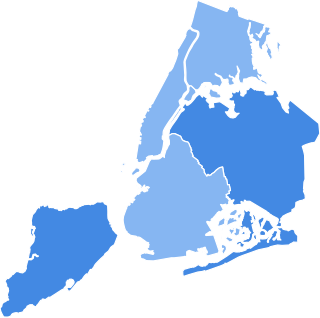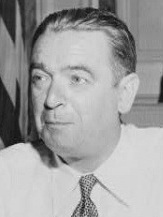
Vincent Richard Impellitteri was an Italian-American politician and judge who served as the 101st Mayor of New York City from 1950 to 1953. He was elected as a Democrat and president of the City Council in 1945 and reelected in 1949. When Mayor William O'Dwyer resigned in 1950, he became acting mayor. He lost the Democratic primary for the nomination for the rest of the term but was subsequently elected mayor on a new ticket, the "Experience Party". He lost the Democratic primary when he ran for a full term in 1953 and became a judge in 1954.
The Liberal Party of New York is a political party in New York. Its platform supports a standard set of socially liberal policies, including abortion rights, increased spending on education, and universal health care.

Robert Ferdinand Wagner II was an American diplomat and politician who served three terms as the mayor of New York City from 1954 through 1965. When running for his third term, he broke with the Tammany Hall leadership, ending the clubhouse's reign in city politics. He also served as United States Ambassador to Spain and in a number of other offices.

The American Labor Party (ALP) was a political party in the United States established in 1936 that was active almost exclusively in the state of New York. The organization was founded by labor leaders and former members of the Socialist Party of America who had established themselves as the Social Democratic Federation (SDF). The party was intended to parallel the role of the British Labour Party, serving as an umbrella organization to unite New York social democrats of the SDF with trade unionists who would otherwise support candidates of the Republican and Democratic parties.

The mayor of New York City is elected in early November every four years, in the year immediately following a United States presidential election year, and takes office at the beginning of the following year. The city, which elects the mayor as its chief executive, consists of the five boroughs, which consolidated to form "Greater" New York on January 1, 1898.

The 1974 New York state election was held on November 5, 1974, to elect the governor, the lieutenant governor, the state comptroller, the attorney general, two judges of the New York Court of Appeals and a U.S. Senator, as well as all members of the New York State Assembly and the New York State Senate.

The 1954 New York state election was held on November 2, 1954, to elect the governor, the lieutenant governor, the state comptroller, the attorney general, the chief judge and three associate judges of the New York Court of Appeals, as well as all members of the New York State Assembly and the New York State Senate.
Rudolph Halley was an attorney and politician from New York City.

The 1952 United States Senate election in New York was held on November 4. Incumbent Republican Senator Irving M. Ives was re-elected to a second term in office over Democrat John Cashmore with a then-record margin of victory.

The 1966 New York gubernatorial election was held on November 8, 1966 to elect the Governor and Lieutenant Governor of New York. Incumbent Republican Nelson Rockefeller won reelection. As of 2022, this is the last time Manhattan voted for a Republican in a statewide election.

The 1969 New York City mayoral election occurred on Tuesday, November 4, 1969, with incumbent Liberal Party Mayor John Lindsay elected to a second term. Lindsay defeated the Democratic candidate, New York City Comptroller Mario Procaccino, and the Republican candidate, state senator John Marchi.

The 1965 New York City mayoral election occurred on Tuesday, November 2, 1965, with Republican Congressman John Lindsay winning a close plurality victory over the Democratic candidate, New York City Comptroller Abraham Beame.

The New York City mayoral election of 1961 occurred on Tuesday, November 7, 1961. Incumbent Democratic Mayor Robert F. Wagner, Jr. won a decisive re-election victory for a third term in office. Wagner defeated the Republican nominee, state Attorney General Louis J. Lefkowitz, and the Citizens Party nominee, New York City Comptroller Lawrence E. Gerosa. Wagner received 51.03% of the vote to Lefkowitz's 34.46%, a Democratic victory margin of 16.57%.

The New York City mayoral election of 1957 occurred on Tuesday, November 5, 1957. Incumbent Democratic Mayor Robert F. Wagner, Jr. won re-election for a second term in office. Wagner defeated the Republican nominee, businessman Robert K. Christenberry.

The 1945 New York City mayoral election took place on November 6, 1945 in New York City. The candidates were King County District Attorney William O'Dwyer, a Democrat, and Jonah J. Goldstein, a Republican judge, as well as other, third party candidates.

The United States Senate special election of 1949 in New York was held on November 8, 1949. On June 28, 1949, incumbent senator Robert F. Wagner resigned due to ill health. On July 7, John Foster Dulles was appointed by Governor Thomas Dewey to fill the vacancy temporarily.

The 1929 New York City mayoral election was held on November 5 in concert with other municipal elections. Democratic incumbent Jimmy Walker defeated Republican challenger Fiorello H. La Guardia in what was considered "a Crushing Defeat to [the] City G.O.P. [delivered]" by Tammany Hall. Socialist candidate Norman Thomas also ran, as did Socialist Labor candidate Olive M. Johnson and former Police Commissioner Richard Edward Enright for the Square Deal Party.

The New York City mayoral election of 1949 took place on November 8, 1949 in New York City. The candidates were incumbent Mayor William O'Dwyer, a Democrat, and former City Council President and 1945 mayoral candidate Newbold Morris, a Republican, as well as other, third-party candidates. Morris was also the nominee of the Liberal Party, and additionally ran on the City Fusion ballot line.

The New York City mayoral election of 1933 took place on November 7, 1933 in New York City. Incumbent Democratic Mayor John P. O'Brien, who was elected in a special election after the resignation of Mayor Jimmy Walker, faced Republican Congressman and 1929 mayoral candidate Fiorello La Guardia, and former acting mayor and President of the New York City Board of Aldermen Joseph V. McKee, who became acting mayor after Walker's resignation until the special election, and ran on the Recovery Party line.

The 1950 New York City special mayoral election was held on November 7, 1950. Incumbent Democratic Mayor William O'Dwyer had resigned as mayor of New York City in August 1950 to become the United States Ambassador to Mexico. As a result, fellow Democrat Vincent R. Impellitteri became acting mayor in August, having to run in the special election in November to serve out the remaining three years of O'Dwyer's term. Ultimately, Impellitteri was not nominated by New York City Democrats in this election. However, Impellitteri won the election as a third-party candidate.


















